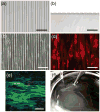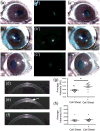Scaffold-free tissue engineering of functional corneal stromal tissue
- PMID: 27863068
- PMCID: PMC5432418
- DOI: 10.1002/term.2363
Scaffold-free tissue engineering of functional corneal stromal tissue
Abstract
Blinding corneal scarring is predominately treated with allogeneic graft tissue; however, there is a worldwide shortage of donor tissue leaving millions in need of therapy. Human corneal stromal stem cells (CSSC) have been shown produce corneal tissue when cultured on nanofibre scaffolding, but this tissue cannot be readily separated from the scaffold. In this study, scaffold-free tissue engineering methods were used to generate biomimetic corneal stromal tissue constructs that can be transplanted in vivo without introducing the additional variables associated with exogenous scaffolding. CSSC were cultured on substrates with aligned microgrooves, which directed parallel cell alignment and matrix organization, similar to the organization of native corneal stromal lamella. CSSC produced sufficient matrix to allow manual separation of a tissue sheet from the grooved substrate. These constructs were cellular and collagenous tissue sheets, approximately 4 μm thick and contained extracellular matrix molecules typical of corneal tissue including collagen types I and V and keratocan. Similar to the native corneal stroma, the engineered corneal tissues contained long parallel collagen fibrils with uniform diameter. After being transplanted into mouse corneal stromal pockets, the engineered corneal stromal tissues became transparent, and the human CSSCs continued to express human corneal stromal matrix molecules. Both in vitro and in vivo, these scaffold-free engineered constructs emulated stromal lamellae of native corneal stromal tissues. Scaffold-free engineered corneal stromal constructs represent a novel, potentially autologous, cell-generated, biomaterial with the potential for treating corneal blindness. Copyright © 2016 John Wiley & Sons, Ltd.
Keywords: cell sheet; cornea; human cells; ocular; scaffold-free; stem cells; transplantation.
Copyright © 2016 John Wiley & Sons, Ltd.
Figures





Similar articles
-
Controlling human corneal stromal stem cell contraction to mediate rapid cell and matrix organization of real architecture for 3-dimensional tissue equivalents.Acta Biomater. 2018 Feb;67:229-237. doi: 10.1016/j.actbio.2017.11.047. Epub 2017 Dec 5. Acta Biomater. 2018. PMID: 29208552
-
The engineering of organized human corneal tissue through the spatial guidance of corneal stromal stem cells.Biomaterials. 2012 Feb;33(5):1343-52. doi: 10.1016/j.biomaterials.2011.10.055. Epub 2011 Nov 10. Biomaterials. 2012. PMID: 22078813 Free PMC article.
-
3D Functional Corneal Stromal Tissue Equivalent Based on Corneal Stromal Stem Cells and Multi-Layered Silk Film Architecture.PLoS One. 2017 Jan 18;12(1):e0169504. doi: 10.1371/journal.pone.0169504. eCollection 2017. PLoS One. 2017. PMID: 28099503 Free PMC article.
-
Corneal regeneration: A review of stromal replacements.Acta Biomater. 2018 Mar 15;69:31-41. doi: 10.1016/j.actbio.2018.01.023. Epub 2018 Feb 1. Acta Biomater. 2018. PMID: 29374600 Review.
-
Development, structure, and bioengineering of the human corneal stroma: A review of collagen-based implants.Exp Eye Res. 2020 Nov;200:108256. doi: 10.1016/j.exer.2020.108256. Epub 2020 Sep 21. Exp Eye Res. 2020. PMID: 32971095 Review.
Cited by
-
The anti-scarring effect of corneal stromal stem cell therapy is mediated by transforming growth factor β3.Eye Vis (Lond). 2020 Nov 3;7(1):52. doi: 10.1186/s40662-020-00217-z. Eye Vis (Lond). 2020. PMID: 33292650 Free PMC article.
-
Graphene-based 3D scaffolds in tissue engineering: fabrication, applications, and future scope in liver tissue engineering.Int J Nanomedicine. 2019 Jul 24;14:5753-5783. doi: 10.2147/IJN.S192779. eCollection 2019. Int J Nanomedicine. 2019. PMID: 31413573 Free PMC article. Review.
-
Corneal stromal stem cells restore transparency after N2 injury in mice.Stem Cells Transl Med. 2020 Aug;9(8):917-935. doi: 10.1002/sctm.19-0306. Epub 2020 May 7. Stem Cells Transl Med. 2020. PMID: 32379938 Free PMC article.
-
Corneal Repair and Regeneration: Current Concepts and Future Directions.Front Bioeng Biotechnol. 2019 Jun 11;7:135. doi: 10.3389/fbioe.2019.00135. eCollection 2019. Front Bioeng Biotechnol. 2019. PMID: 31245365 Free PMC article. Review.
-
Engineering topography: Effects on corneal cell behavior and integration into corneal tissue engineering.Bioact Mater. 2019 Oct 25;4:293-302. doi: 10.1016/j.bioactmat.2019.10.001. eCollection 2019 Dec. Bioact Mater. 2019. PMID: 31709312 Free PMC article. Review.
References
-
- Levin LA, Adler FH. Adler’s physiology of the eye : clinical application. 11. Edingburg: Saunders/Elsevier; 2011.
-
- Smolin G, Foster CS, Azar DT, Dohlman CH. Smolin and Thoft’s the cornea : scientific foundations and clinical practice. 4. Philadelphia: Lippincott Williams & Wilkins; 2005.
-
- Fini ME. Keratocyte and fibroblast phenotypes in the repairing cornea. Progress in retinal and eye research. 1999;18:529–51. - PubMed
Publication types
MeSH terms
Grants and funding
LinkOut - more resources
Full Text Sources
Other Literature Sources

